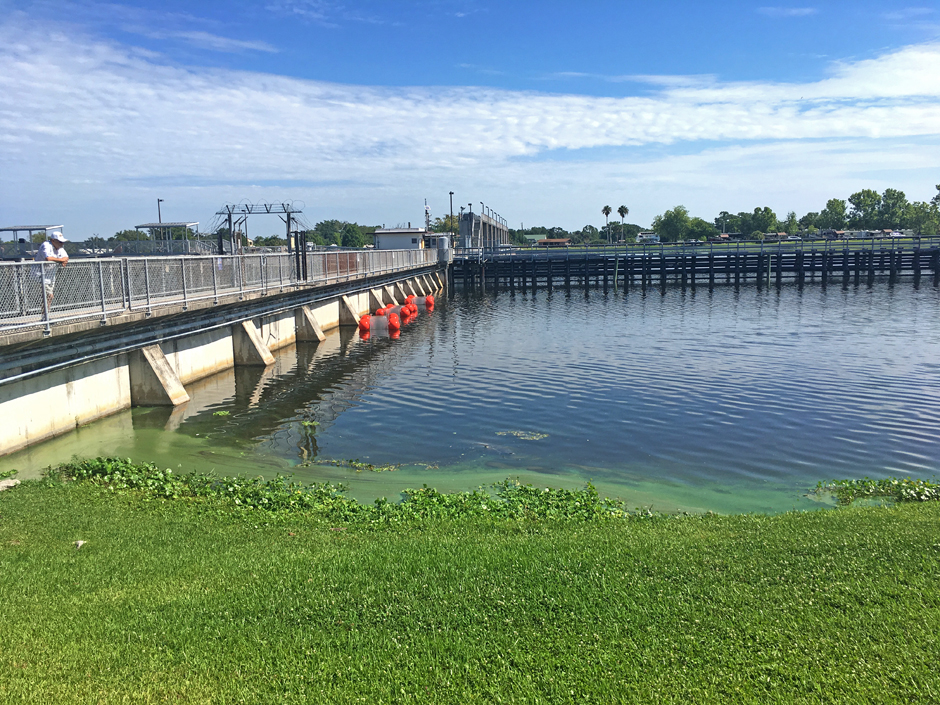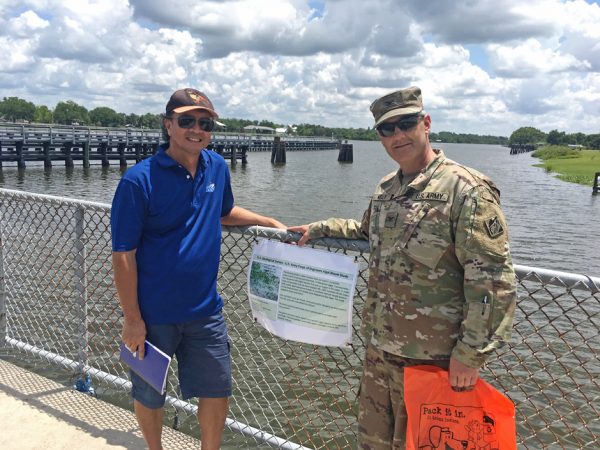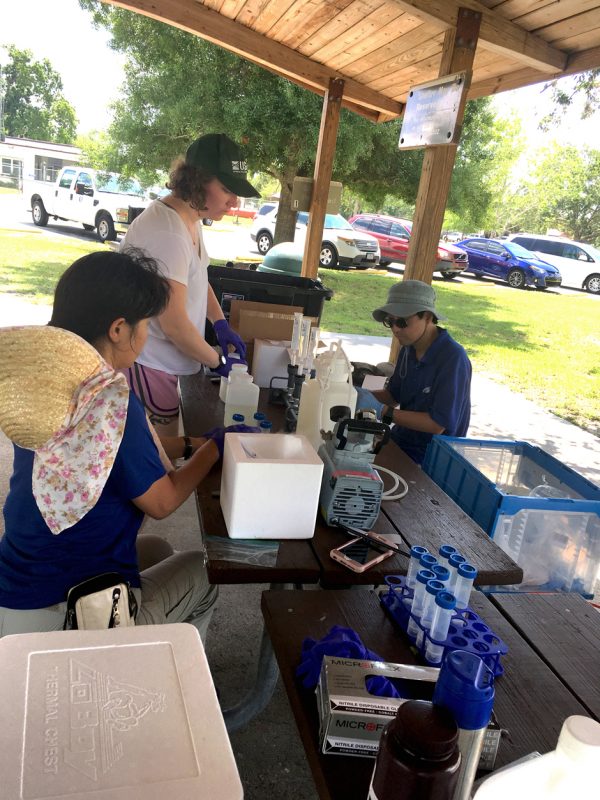A Lesson in Persistence: Taking On Cyanobacteria in Florida
 S-79 Lock, which also shows the experimental mesocosms which were set up by our US Geological Society collaborators (led by Dr. Barry Rosen). There is actually a mini- cyanobacterial bloom in the foreground. (Credit: via Dr. Jose Lopez)
S-79 Lock, which also shows the experimental mesocosms which were set up by our US Geological Society collaborators (led by Dr. Barry Rosen). There is actually a mini- cyanobacterial bloom in the foreground. (Credit: via Dr. Jose Lopez)As we hear more and more about algal blooms of different kinds across the United States, teams of scientists are working hard to ensure that they don’t become our new normal. One project in Florida is taking a multi-disciplinary approach to the problem—including genetic analysis.
The team’s work is part of a full-court press in Florida recently, making a serious push to understand what is triggering more frequent blooms. Jose Lopez, Ph.D., of Nova Southeastern University, the primary investigator on the genetic analysis portion of the project, spoke to EM about the project and his work on it.
“This is a very good project,” explains Dr. Lopez. “We’re excited about it, and it’s a lesson in persistence.”
Dr. Lopez’s primary collaborator on the project is Dr. Barry Rosen, a USGS scientist and faculty member at Florida Gulf Coast University in Fort Myers. Dr. Rosen is a cyanobacterial biologist, specializing in culturing bacteria that can photosynthesize.
“Barry and I have been thinking about this project on cyanobacterial blooms, also known as harmful algal blooms, which are just a subset of all the possible algae blooms there are, for about three years now,” details Dr. Lopez. “We’re trying to throw the kitchen sink, so to speak, at the algae blooms here in Florida. It’s very timely right now, we don’t know the exact causes of these things, but most likely climate change and warming temperatures are a factor. They simply help things grow, as we know, especially primary producers like cyanobacteria.”
There was a large HAB in Florida in 2016, in particular, that caught national attention for its thickness and resemblance to guacamole. That HAB sat on the east coast of Florida.
“That affected a lot of businesses, if I remember correctly, around the July 4th holiday in 2016,” recalls Dr. Lopez. “It didn’t happen again in 2017, but there were several blooms in 2018. It’s a kind of an intermittent thing, and people don’t really know what causes these blooms, so that’s our main question: can we determine what are the switches that cause cyanobacteria to just burst forth and take over an area of waterway?”
A focus on the Lake Okeechobee Watershed
The team is focused on the Lake Okeechobee Watershed for this project for several reasons.
“It’s an important watershed, and the biggest lake in Florida,” Dr. Lopez describes. “It’s also surrounded by wetlands and sugar farms. Further south, of course, is the Everglades. To the east are coral reefs, which I’ve been interested in working on for years. Here at Nova Southeastern University, our lab is just adjacent to the coral reefs and Port Everglades inlet.”
Although it’s a bit of a switch for Dr. Lopez to go inland and look at freshwater aquatic habitats, the team can apply the same methods of characterizing microbes in the water using genetic techniques. In fact, the genetic techniques are essential to the work.

Prof Jose Lopez stands with US Army Corp of Engineers Commander Andrew Kelly at Lock S-79. The USACE provided funding to Dr. Lopez and Nova Southeastern University for this harmful algal project in S. Florida. (Credit: via Dr. Jose Lopez)
“We use genetic techniques because we can’t culture a majority of bacteria that live in a habitat in any given ecosystem,” remarks Dr. Lopez. “About 90 percent cannot be put on a petri dish. So the only way we can really study them and get a handle on what species are there and what they’re doing is by reading what genes are there, what their genomes are, and what RNA is expressed.”
This is the reason for the team’s heavy focus on molecular biology and molecular gene sequencing in the project.
“We’re going to be looking at transcriptomes and meta transcriptomes; these are the unculturable community that’s there,” Dr. Lopez elaborates. “Most habitats have a community of bacteria. We’re looking across the whole consortium of species that might be living in the water, and we hypothesize an interaction there that may be controlling the algae blooms or not.”
In fact, although cyanobacteria are also known as blue-green algae colloquially, there are technically many different species of bacteria in the water. It is mostly cyanobacteria that can photosynthesize, and the primary species that scientists know grows in Lake Okeechobee, the Caloosahatchee River that feeds it, and in nearby waterways is Microcystis.
“Our primary focus has been on two different ideas,” remarks Dr. Lopez. “One is a synthetic approach, using mesocosms on the Caloosahatchee River.”
These are closed systems where the team can safely collect actual river water and add nutrients such as ammonia, phosphorous and nitrates to it in higher doses without environmental impact.
“The idea is to cause an artificial bloom in these mesocosms, which we’ve already started to do,” states Dr. Lopez. “We can compare that with what’s happening naturally in Lake Okeechobee. We’ve asked our partners to collect water samples from the lake and other parts of the watershed, and we’re going to profile the natural communities in those samples.”
This takes some of the team out of the lab and into the field. The team conducted their first mesocosm run in May 2019, and the second run in mid-summer, with the idea that they might pick up some new species of cyanobacteria. The third run was scheduled for September after the peak season.
“Maybe there will be a bloom this year, maybe not,” comments Dr. Lopez. “But we’re trying to look at the profiles before, during, and after a bloom to see which genes are on and off at each of those periods across this temporal gradient. That might give us some clues as to what’s causing these cyanobacteria to bloom.”
A layered approach to a complex, interconnected world
This team of collaborators boasts experts specializing in very different areas, which speaks to the complexity of the HAB problem. Any number of factors, such as winds or physical systems, could also be impacting these blooms.
“It is very complex, because first of all, it’s a community in water, so you’ve got hundreds of species there,” says Dr. Lopez. “We also know that there are nutrients getting into the waterway that have increased these changes in our water. We don’t really know which ones might be driving the bloom, so that’s why we’ve isolated a few to start with. We know those are probably being introduced from agriculture.”
But there are also numerous human activities in this watershed that are probably having an impact.

Team member processing water samples at S-70. This includes USGS scientist Emily Karwacki and collaborators Prof Hidetoshi and Haruka Urakawa, from Florida Gulf Coast University. (Credit: via Dr. Jose Lopez)
“But there are also impacts from the rising population around the Lake,” explains Dr. Lopez. “In Florida in general, we have septic tanks, which means high nutrient loads. It costs money to put people on sewer lines, but it would protect our environment a lot better. Climate change, runoff from the cities, we’re going to be able to tackle just a few of those parameters. We’re going to try to do it systematically, and hypothesize about the specific nutrients that we think are in the water based on the activity.”
Perhaps the most interesting reveal from this work, however, will be the deeper profile of these bacterial communities—most of which remain mysterious. Just knowing more about these interactions may help crack the HAB problem.
“Using the latest genetic methods and algorithms, I’ll think we’ll get an idea of how these species interact with each other,” Dr. Lopez states. “We think that certain heterotrophic bacteria might be affecting the cyanobacteria. These are the consuming bacteria that are also normally there, and they might not necessarily cause any problems. However, I think when the conditions are just right, something triggers the cyanobacteria to start choking, and they begin reproducing uncontrollably.”
The toxins in cyanobacteria may not be as bad as the red tide, which cause respiratory ailments. But just having too much overgrowth of the cyanobacteria is bad.
“It causes anoxia in the water, as they degrade, and overall it’s an imbalance in the system,” clarifies Dr. Lopez. “We’re seeing more and more of a tipping point with more frequent blooms, and that’s a sign to us that something is not normal. If we can determine what those factors are, we’ll work with local managers and agencies which monitor water quality to help improve it. Florida is a water state, of course, and we’d like to see it improve and get back to where it was.”
For the team, it’s not just research: it’s personal.
“I used to go fossil hunting in the Peace River years ago, which was crystal clear. I haven’t been there lately, but it has probably changed. Too many nutrients getting into that water could compromise it, and change the balance of the water, and the communities that are there. Our application of these new techniques to understand what these communities are, now, before a bloom, and to see what triggers the communities to change under the optimal bloom conditions, is timely.”
In fact, looking at genetic factors is a natural water quality study area, and a smart extension of the field, albeit a relatively new one. Still, today’s problems demand the application.
“This is happening all over the world, there are blooms in Lake Erie, blooms in China, etc,” comments Dr. Lopez. “People are just not going to jump in the water with a mat of algae on top of it. So it’s about time.”
Dr. Lopez adds: “Better understanding of the human microbiome helps us appreciate that we’re symbionts, living together in association with other creatures. The majority of them are beneficial. Cyanobacteria are the ones who created the oxygen atmosphere a couple of billion years ago, so they’re one of the oldest bacteria on the evolutionary tree. They tend to have big genomes, some of which we might be able to sequence during this project. We’ll likely find some new species and, yes, some insight into what’s happening in Lake Okeechobee.”




0 comments